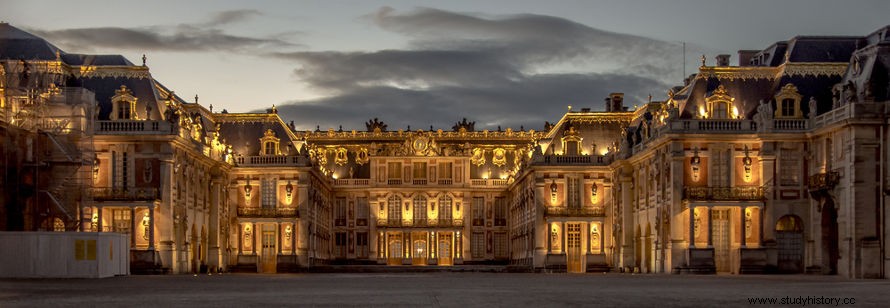
The Palace of Versailles began to be built, in its current form, in the reign of Louis XIV , king who ruled France between 1661 and 1715 and who became known as the Sun King. This palace is the great symbol of the power of monarchs in absolutist France, in addition to being the great icon that represents the luxurious standard of living of kings and nobility. The Palace of Versailles was the home of French kings from 1682 to 1789.
See also: Absolutism
Construction of the Palace of Versailles
It is considered that the construction of the Palace of Versailles began by order of King Louis XIV, the most powerful French king of the absolutist period. The French call the palace the Château de Versailles , which, in a literal translation, means Castle of Versailles. However, it is important to clarify that, in France of the Renaissance period, the word “château ” was used to refer to palaces that were located in rural areas. For palaces built in urban centers, the word used was “palais ”.
The Palace of Versailles emerged as a rural hunting lodge used by Louis XIII , King of France, between 1610 and 1643. It all started when Louis XIII went to the region of Versailles, located on the outskirts of Paris, to hunt in the forests. Over time, Louis XIII took a liking to the place and ordered, in 1623, the construction of a small country house.
Shortly later, in 1631, Louis XIII ordered the reconstruction of the country house. This work began in 1631 and was completed in 1634. This renovation resulted in the development of the base of what is now the palace. So, what was just a country house turned into a small palace.
The history of the Palace of Versailles changed radically when Louis XIV was crowned King of France. Louis XIV ruled France from 1643 to 1715. The Sun King, as he called himself, was the personification of the power of absolutist monarchs and lavished an extremely luxurious lifestyle, of which the construction of the Palace of Versailles is a symbol.
The Palace of Versailles during the reign of Louis XIV
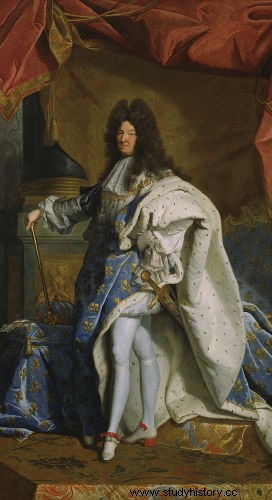
Louis XIV, King of France from 1643 to 1715, was responsible for ordering the construction of the Palace of Versailles.
Louis XIV decided to renovate the Palace of Versailles in 1661, shortly after the death of his prime minister, Cardinal Mazarin . Louis' idea was to make the palace bigger and more beautiful. For this, he hired the architect Louis Le Vau to design the palace expansion project. During the reign of Louis XIV, Versailles was transformed into a gigantic and luxurious palace, becoming the seat of the administration of France and the place of parties for the nobility and the French court.
The expansion works at Versailles lasted throughout the reign of Louis XIV and continued even after his death. Places such as the Gallery were built in Versailles during the reign of Louis XIV. dos Mirrors , the Big Trianon , the north and south wings of the palace, the Chapel Real, etc. Apart from the palace itself, there is also the immensity of gardens located at the back of the mansion.
To design the gardens, Louis XIV hired André Le Nôtre. This construction dragged on for several decades and was only completed during the reign of Louis XVI. Two prominent places can be mentioned:the Orange Grove and the Big Channel .
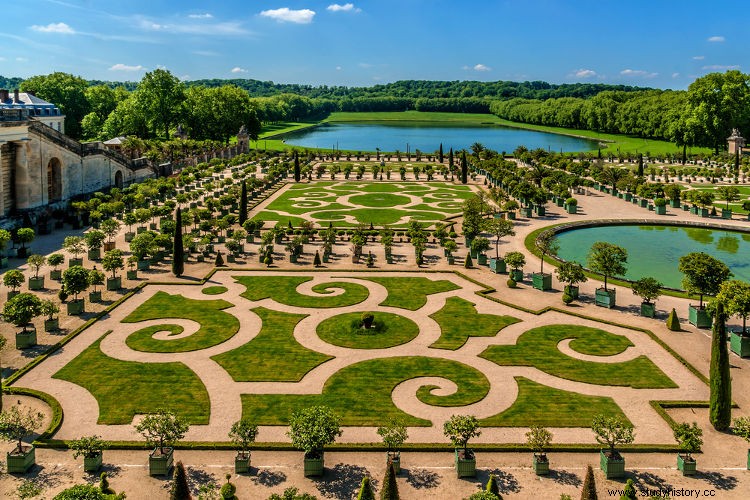
Laranjal, one of the gardens built at the back of the Palace of Versailles.
In 1682, Louis XIV decreed that the Palace of Versailles would be the seat of the French court and government. With that, the aristocracy and the administrative body of France abandoned Paris and moved to Versailles. The Palace of Versailles remained the seat of the French Crown until 1789, when King Louis XVI and his wife Marie Antoinette were forced to move to Paris during the French Revolution .
Palace of Versailles in history
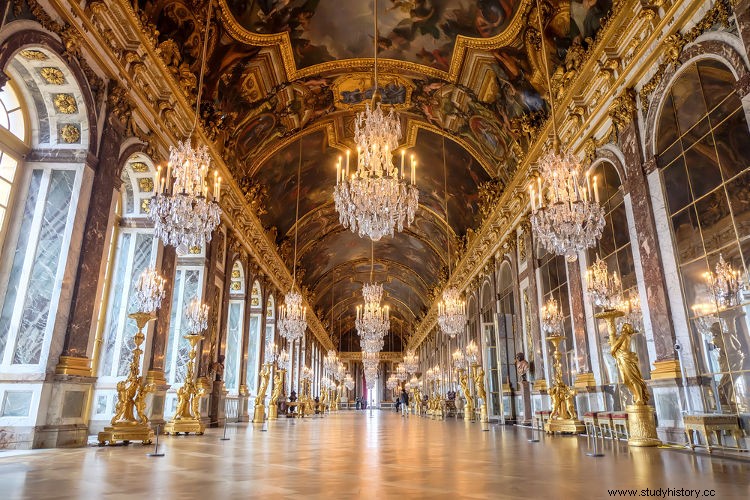
Hall of Mirrors, where the peace treaties of the Franco-Prussian War and World War I were signed.*
In 1833, the Palace of Versailles was transformed by order of King Louis Philippe I, in a museum dedicated to “all the glories of French history”. Officially as a museum, it became a place for the exhibition of articles from French history ranging from the medieval period to the 19th century. Despite this, it continued to be explored as a venue for important French government events.
During the Paris Commune in early 1871, the Palace of Versailles received French parliamentarians who had fled Paris. A few months later, he received the French and Prussian delegations, who signed, in the Hall of Mirrors, an agreement that put an end to the Franco-Prussian War . In the 20th century, after the end of the First World War, the Hall of Mirrors received diplomatic delegations that signed the Treaty of Versailles.
See also: Unification of Germany
Currently, the Palace of Versailles is just a museum and is even one of the most visited places in all of France, receiving millions of visitors annually. As recently as 1999, a strong storm hit the palace, resulting in massive destruction. During this storm, around 10,000 trees were damaged, which represented a loss of 250 million francs for the French government.
The palace is open to visitors six days a week. The only day it doesn't open is Monday. The gardens and parks are open every day. Visits to the palace are paid, but under certain conditions, visitors can request free admission.
Gardens of the Palace of Versailles
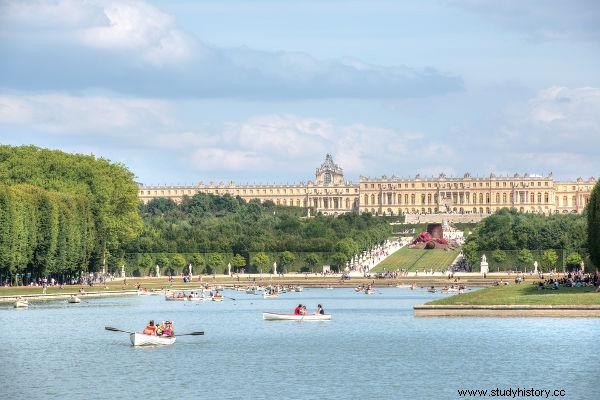
In the image, the Grand Canal and the Palace of Versailles in the background.**
Aside from the gigantic structure of the palace, Versailles is also well known for the beautiful and extensive gardens that were built in its external area. Part of the gardens that exist in the Versailles complex can be seen from the Hall of Mirrors. The construction of the gardens was ordered by King Louis XIV and is considered as important as the gardens themselves.
As mentioned, Louis XIV appointed André Le Nôtre as responsible for the construction of the gardens, whose development required a great effort, as it was necessary to remove a large amount of land from Versailles to level the ground. In addition to the gardens, hundreds of fountains were also built, and trees from different parts of France were brought to Versailles.
The entire complex of gardens at Versailles has parterres, fountains, groves and canals, such as the Parterre da Água , the Orange grove , the Source from Dragon , the Big Channel , the Wood das Three Fonts, etc.
Fun facts about the Palace of Versailles
The Palace of Versailles is gigantic, both the palace itself and its gardens. Therefore, we highlight some information about this palace:
-
The entire palace complex, including the gardens, has about 67,000 m 2 .
-
It has about 60,000 pieces relating to French history.
-
It has around 700 rooms, 2,000 windows, 67 staircases and over 1,000 fireplaces.
In addition to information about the physical structure of the palace, other curiosities can also be raised, such as:
-
The Hall of Mirrors was built between 1678 and 1684 and has a total of 357 mirrors.
-
The Palace of Versailles hosted delegations that signed the peace treaties of two wars:Franco-Prussian War and World War I. These treaties were signed in 1871 and 1919, respectively.
-
At the Palace of Versailles, the Treaty of Paris was also signed in 1783, through which the British recognized the independence of the United States.
-
During the French Revolution, the Palace of Versailles was invaded, and King Louis XVI and his wife Marie Antoinette were forced to move to Paris.
P>
-
In the Galleria das Batalhas, there are 33 paintings that narrate French history, from Clovis to Napoleon Bonaparte.
-
In the Gallery of Battles, 80 busts of great French officers who were killed in battle are also found.
-
In 1999, a major storm with winds above 200 km/h hit the palace and caused 10,000 of the 200,000 trees in the palace to be damaged.
*Image Credits:Mister_Knight and Shutterstock
**Image Credits:Bigmagic and Shutterstock
